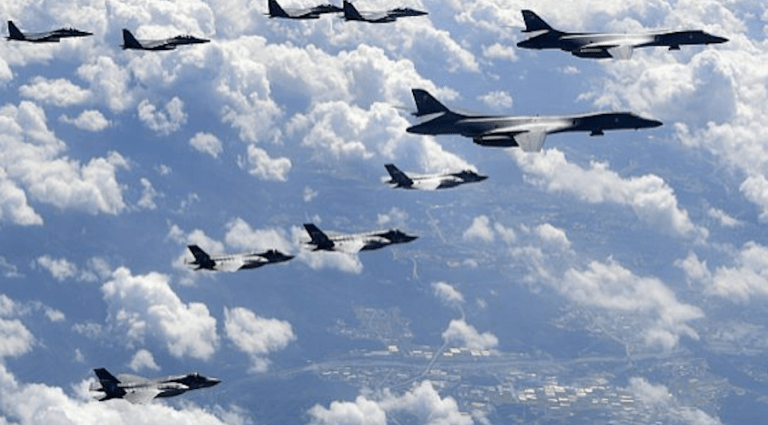The recent resurgence of public debate over nuclear weapons in South Korea can be attributed to both Korean peninsula and global drivers. South Korean support for nuclear weapons reveals the country’s desire for greater agency and control over its ability to respond to evolving and uncertain external security challenges.
The greatest driver of these desires is North Korea. North Korea’s record number of missile test launches in 2022, revised nuclear doctrine stipulating conditions for nuclear first use and Kim Jong Un’s speech outlining an “exponential increase of the country’s nuclear arsenal” underscore the changing threat.
The dual focus on tactical nuclear weapons and intercontinental ballistic missiles highlights North Korea’s aim to sow doubt within the US-South Korea alliance by simultaneously threatening both South Korean and US cities.
Frustrations with the perceived lack of priority and engagement by the United States on the North Korea issue have contributed to domestic doubts regarding US ability and will to achieve a resolution. Such frustrations have fuelled calls for a new policy approach toward North Korea.
Criticism of past missed opportunities and failed efforts to achieve meaningful steps toward North Korea’s denuclearisation have energized arguments that a policy of nuclear parity is most realistic given the difficulties of denuclearizing North Korea in the near future.
Recent calls to scrap the 1992 Joint Declaration of the Denuclearization of the Korean Peninsula further highlight the push by some South Koreans to abandon the short-term objective of denuclearization in favor of a more muscular and proactive policy of nuclear armament to achieve nuclear balance.
In a 2022 poll, half of South Korean specialists surveyed predicted that the existing asymmetric balance of military power on the Korean peninsula, where North Korea possesses a quantitative advantage and South Korea possesses a qualitative advantage, is likely to continue.
Under this “double asymmetry of power“, both North and South Korea will continue to feel vulnerable and uneasy about the other’s asymmetrical military advantage.

The current debate over nuclear development is a response to the immediate threat posed by North Korea’s increased provocations and advancements in capabilities. It also reflects a long-term assessment regarding the preferred pathway toward peace and stability on the Korean peninsula.
These domestic arguments have only strengthened in response to global developments that underscore growing uncertainty and instability related to changes in the broader security environment. The war in Ukraine has shifted South Korean thinking.
It illustrates the potential risks associated with renewed conflict with North Korea and the perceived difficulties of conventionally deterring and overpowering a nuclear-armed country that utilizes nuclear coercion and threats of escalation.
The intensifying US-China strategic competition further limits the likelihood of a regional cooperative approach toward North Korea and the ability of the UN Security Council to impose sanctions to limit North Korean testing.
As North Korea continues to test and advance its weapons under the blanket of immunity provided by both Russia’s invasion of Ukraine and growing US-China rivalry, South Koreans will continue to debate the viability of nuclear armament.
In this sense, nuclear weapons are viewed as a tool for securing South Korea’s invulnerability to external security challenges and ensuring it has the deterrent and defense capabilities necessary to withstand global unpredictability.
Proponents and opponents of an autonomous South Korean nuclear capability differ in their assessments of how a nuclear South Korea would impact regional security. Nuclear advocates argue that the nuclear domino effect has already arrived in Northeast Asia due to the proliferation of North Korea’s nuclear arsenal and the growing imbalance between nuclear and non-nuclear countries in the region.
But both South Koreans opposed to nuclear armament and US nonproliferation specialists believe that a nuclear South Korea would prompt a regional arms race. China and North Korea would likely accelerate military modernization efforts in response to such a development and Japan might similarly consider its own independent nuclear deterrent.
US acquiescence to a nuclear South Korea would require a reinterpretation of the longstanding US policy of nonproliferation toward its allies and a readjustment of US force and nuclear posture in Northeast Asia.
On the contrary, US opposition to South Korean nuclear armament would weaken, if not threaten to destroy, the bilateral alliance and subject South Korea to various political and economic consequences.

In its current state, it would be premature to make predictions regarding the future direction of the nuclear debate in South Korea. South Koreans have debated an independent nuclear program since North Korea tested its first nuclear weapon in 2006.
As long as North Korea possesses usable nuclear weapons, a dedicated portion of the public and elites will continue to argue for the acquisition of nuclear weapons as a necessary security measure to balance North Korea’s nuclear arsenal.
The strength, activity and momentum of the debate will likely be contingent on how South Koreans view the threat posed by North Korea and the relative stability and reliability of the regional and global security environment.
Jennifer Ahn is Research Associate for Korea Studies at the Council on Foreign Relations.
This article, republished with permission, was first published by East Asia Forum, which is based out of the Crawford School of Public Policy within the College of Asia and the Pacific at the Australian National University.

